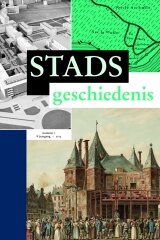Stadsgeschiedenis editie 2013 - 1

|
Alexander Soetaert & Bram Vannieuwenhuyze Ellen Debackere Stefan Couperus (Review) Ariadne Schmidt & Marion Pluskota (Review) Maarten F. Van Dijck, Inge Bertels, Petra Brouwer & Jeannete Kamp (Interview) Petra Brouwer |
Abstracts
Alexander Soetaert & Bram Vannieuwenhuyze, Medieval Namur on the banks of the river Sambre and/or Meuse. Urban history subject to topographic representation and prejudices
This article takes the ‘river debate’ in Namur as a starting point for reflection upon topographic prejudices among scholars studying historical urban topography. On the one hand, the case study turns out to be quite particular, since historians explaining the medieval development of the town could not get round to take position in the debate, by ascribing a primordial role either to the Sambre or to the Meuse. On the other hand, the case clearly demonstrates how historians implicitly divide and hierarchize the historical urban topography, often in order to emphasize the particularities of their town or field of study.
Ellen Debackere, Shopkeeping in a capital. Brussels shopkeepers and their location patterns at the beginning of the nineteenth century
In the aftermath of the spatial turn, consumption historians became aware of the importance of commercial activities’ spatial location and uncovered that shopkeepers’ location patterns in some early modern cities did not fundamentally differ from those being explained by modern location theories. Brussels shopkeepers in the second half of the eighteenth century did, however, still seem to be positioned near marketplaces and therefore differed from those towns whose merchants were located in a rather ‘modern’ way. By sketching out the profile and especially the spatial location of the Brussels shopkeepers, this article attempts to investigate the extent to which these retail traders underwent transformations at the beginning of the nineteenth century, and to which degree they were influenced by the metropolitan context.
Stefan Couperus, In the shadow of the plan, in the light of the community. Alternative reconstruction in Coventry and Rotterdam, 1944-1956
The reconstruction of Europe’s blitzed cities during the Second World War has attracted significant scholarly interest. However, historiography still tends to revolve around a single metanarrative of urban redevelopment which is informed by town planning, architectural reform, their main advocates (planners and architects), and the concomitant implementation and execution of plans. This reading of post-war reconstruction tends to neglect other discourses on urban life and urban planning which addressed the particular circumstances of war and destruction as well. This article presents two alternative reconstruction experiments in the blitzed cities of Coventry and Rotterdam in order to reveal elements of a modernist discourse on urban reconstruction which do not exclusively capitalize on spatiality, design and its alleged social implications.
Ariadne Schmidt and Marion Pluskota, Dangerous women, violent men? A review of the historiography of crime and gender in European cities, 1600-1900
This paper presents a review of the historiography on gender and crime in Europe in the period between 1600 and 1800, starting from Beattie’s seminal article highlighting the absence of women in the history of crime, to the most recent works on the process of gendering crime and on revaluating men’s participation in ‘female crimes’. It discusses subsequently the strengths and weaknesses of the main approaches in the historiography, the moral and judicial norms influencing both criminal behaviour and the prosecution of crime, male and female criminality, violence, the urban setting of criminality and the decline of female crime rates during the nineteenth century. Further, the conclusion presents suggestions for future research and encourages a systematic comparison of male and female crime over time and space and a focus on different types of towns to get a better understanding of the dynamics and fluctuations in gender differences in the history of crime.